In the intricate dance of life that unfolds within every plant cell, meiosis stands as a pivotal choreography, ensuring genetic diversity and faithful chromosome segregation. A recent groundbreaking study by Feng, Lorenz, Dreissig, and colleagues unravels the molecular intricacies of this process in the model organism Arabidopsis thaliana, revealing the vital role of the synaptonemal complex central element SCEP3. Published in Nature Plants in 2025, this research bridges the crucial gap between synapsis initiation and crossover formation, offering unprecedented insights into the orchestration of meiotic recombination and chromosomal behavior.
Meiosis, the specialized cell division that generates gametes, relies heavily on the synaptonemal complex (SC), a proteinaceous scaffold that aligns homologous chromosomes to facilitate genetic exchange. The central element of the SC, often overshadowed by its lateral components, has emerged as a fundamental architect of chromosomal dynamics. In Arabidopsis thaliana, SCEP3 constitutes this central element, implicated in maintaining the structural integrity of the SC and coordinating downstream events that ensure successful crossover formation.
The study expertly combines cutting-edge cytogenetic techniques, live-cell imaging, and genetic analyses to decipher SCEP3’s multifaceted role. The authors demonstrate that SCEP3 is not merely a passive structural component but an active integrator that synchronizes synaptonemal complex assembly with the initiation of recombination nodules. This coupling is vital, as erroneous synapsis or impaired crossover events can lead to chromosomal missegregation and infertility.
Delving deeper, Feng et al. reveal that loss-of-function mutations in SCEP3 result in profound defects in synapsis, characterized by incomplete homolog alignment and disrupted SC morphology. These structural perturbations are accompanied by a marked reduction in crossover frequency, underscoring the protein’s importance in fostering genetic exchange. Intriguingly, despite the defective synapsis, early recombination markers are still recruited to chromosome axes, suggesting that SCEP3 acts downstream of initial recombination complex formation to facilitate crossover maturation.
Molecular interrogation into SCEP3’s domain architecture uncovers conserved motifs that likely mediate protein-protein interactions within the SC. These domains appear essential for anchoring crossover-promoting factors and stabilizing the central element scaffold. This structural functionality positions SCEP3 as a nexus, orchestrating both the assembly of the synaptonemal complex and the timely progression of recombination events necessary for crossover resolution.
The implications of this research transcend Arabidopsis, providing a template for understanding similar processes in other eukaryotes. The synaptonemal complex is a conserved meiotic structure, and elucidating the role of central element components may illuminate causes of infertility and chromosomal disorders linked to meiotic failures in higher organisms, including humans. SCEP3, or its homologs, could represent targets for interventions that modulate crossover frequency, an avenue with potential applications in plant breeding and genetic improvement.
Feng and colleagues further explore the interplay between SCEP3 and established meiotic proteins. Their data suggest that SCEP3 interacts with axis-associated proteins and recombination machinery, mediating cross-talk that ensures synapsis initiation is tightly coupled to crossover designation. This coordination is critical for maintaining genomic stability and preventing aberrant recombination outcomes.
Advanced microscopy reveals dynamic localization patterns of SCEP3 during meiotic prophase I. Initially appearing during early synapsis initiation, SCEP3 accumulates at the central element as homologs progressively align, persisting through crossover maturation stages. These temporal dynamics indicate that SCEP3 functions as a scaffold that adapts throughout meiosis, supporting various structural and biochemical activities.
The study also implicates SCEP3 in modulating crossover interference, the phenomenon whereby one crossover event suppresses the occurrence of nearby crossovers. Mutants lacking functional SCEP3 exhibit altered frequencies and distribution patterns of crossovers, suggesting the protein contributes to the spatial regulation of genetic exchange. This insight adds a new layer to the understanding of how recombination landscapes are shaped within chromosomes.
Another fascinating discovery is the connection between SCEP3 and DNA repair pathways. Meiotic recombination is initiated by programmed double-strand breaks, subsequently repaired to form crossovers or non-crossovers. SCEP3 appears to facilitate the recruitment of repair factors that channel DNA repair toward crossover outcomes, influencing the balance of genetic shuffling versus maintenance of sequence integrity.
Crucially, this research integrates biochemical assays demonstrating that SCEP3 forms multimeric complexes, stabilizing the synaptonemal complex structure. This clustering ability may be instrumental in transforming transient protein interactions into durable assemblies necessary for chromosome pairing. The stability conferred by SCEP3-containing complexes ensures that homologs remain tightly connected, enabling efficient crossover formation.
From an evolutionary perspective, the conserved nature of SCEP3 motifs suggests selective pressure to maintain this protein’s function across plant species. This hints at the universality of synaptonemal complex mechanisms, despite the diversity of meiotic regulatory networks. Future comparative studies may uncover adaptive modifications of SCEP3 function that correspond to species-specific reproductive strategies.
The ramifications of understanding SCEP3’s role extend beyond basic biology. In agricultural biotechnology, manipulating synapsis and crossover pathways can expedite the generation of novel crop varieties with desirable traits. By harnessing proteins like SCEP3, breeders might increase crossover rates or target recombination to specific genomic regions, overcoming traditional breeding barriers.
In summary, this seminal study by Feng et al. redefines the synaptonemal complex central element SCEP3 from a static scaffold component to a dynamic coordinator interlinking synapsis initiation with crossover formation. Through meticulous experimentation and robust analysis, the researchers illuminate critical molecular cogs powering meiosis in Arabidopsis thaliana, setting a new paradigm for the field.
As interest grows in meiotic regulation, SCEP3 represents a promising molecular entry point for deeper exploration, laying the foundation for translational applications in plant science and reproductive genetics. Future research will undoubtedly expand upon these findings, exploring SCEP3 interactions and regulatory mechanisms in various biological contexts, continuing to decipher the complex choreography of life’s most fundamental process.
Subject of Research: The synaptonemal complex central element SCEP3 and its role in synapsis initiation and crossover formation during meiosis in Arabidopsis thaliana.
Article Title: The synaptonemal complex central element SCEP3 interlinks synapsis initiation and crossover formation in Arabidopsis thaliana.
Article References:
Feng, C., Lorenz, J., Dreissig, S. et al. The synaptonemal complex central element SCEP3 interlinks synapsis initiation and crossover formation in Arabidopsis thaliana. Nat. Plants (2025). https://doi.org/10.1038/s41477-025-02030-9
Image Credits: AI Generated




